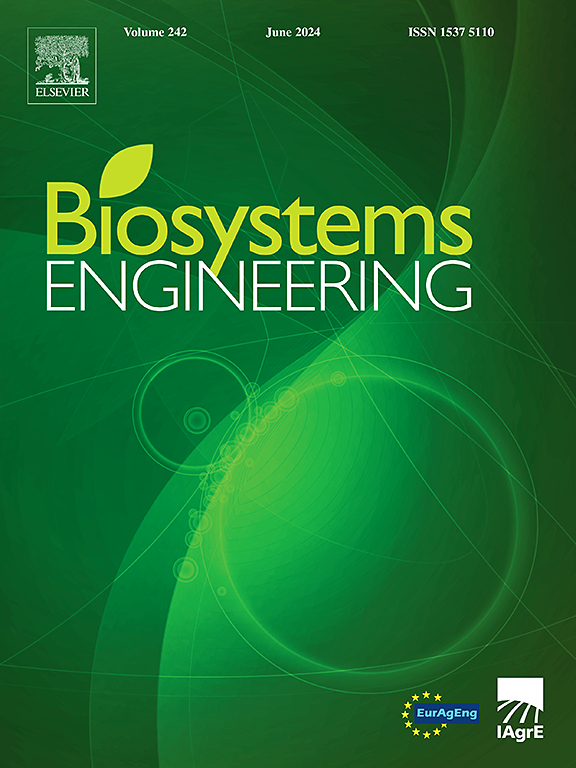利用三维植物扫描估计玉米气孔导度
IF 5.3
1区 农林科学
Q1 AGRICULTURAL ENGINEERING
引用次数: 0
摘要
鉴于争夺蓝水的冲突预计将加剧,优化灌溉将变得越来越重要。尽管气孔导度(gs)是最有可能量化作物水分状况的变量之一,但进行测量的困难和成本阻碍了其在业务环境中的使用。提出了一种基于智能手机叶片三维扫描估计玉米叶片gs的模型,该模型是倒数第二叶的叶片插入角和顶部冠层叶片曲率度的函数。该模型是根据红外气体分析仪(IRGA)的gs测量值对三种玉米杂交品种进行评估的,使用的数据来自一个专门的盆栽试验,该试验采用了不同的灌溉处理。对于两个杂交品种,IRGA和模型的gs值之间的一致性是令人满意的(R2 = 0.78和0.73),而第三个杂交品种的结果稍差(R2 = 0.51)。3个杂交种对水分胁迫的响应表现为减小/增大插入角和叶片拉直/弯曲的不同行为,这导致了两种预测因子的基因型特异性系数。gs和冠层建筑指标之间的关系可以在基于激光雷达或多视点立体成像的监测平台中实施,为开发改进系统以优化操作农业条件下的灌溉开辟了新的机会。本文章由计算机程序翻译,如有差异,请以英文原文为准。
Estimating stomatal conductance in maize from 3D plant scans
Given conflicts for blue water are projected to exacerbate, optimising irrigation will be increasingly crucial. Despite stomatal conductance (gs) being among the variables with the greatest potential to quantify crop water status, the difficulties and the cost of performing measurements have prevented its use in operational contexts. A model is proposed for estimating gs in maize from smartphone-based 3D leaf scans, as a function of leaf insertion angle of the penultimate leaf and the degree of leaf curvature in the top canopy layers. The model was evaluated – against gs measurements from an infrared gas analyser (IRGA) – for three maize hybrids using data from a dedicated pot experiment where different irrigation treatments were applied. The agreement between gs values from IRGA and from the proposed model was satisfactory for two hybrids (R2 = 0.78 and 0.73), whereas slightly poorer results were achieved for the third one (R2 = 0.51). The three hybrids responded to water stress by adopting different behaviours in terms of reducing/increasing insertion angles and of straightening/curving leaf blades, leading to genotype-specific coefficients for the two predictors. The relationships between gs and canopy architectural indicators could be implemented in monitoring platforms based on LIDAR or multi-view stereo imaging, opening new opportunities for developing improved systems to optimise irrigation under operational farming conditions.
求助全文
通过发布文献求助,成功后即可免费获取论文全文。
去求助
来源期刊

Biosystems Engineering
农林科学-农业工程
CiteScore
10.60
自引率
7.80%
发文量
239
审稿时长
53 days
期刊介绍:
Biosystems Engineering publishes research in engineering and the physical sciences that represent advances in understanding or modelling of the performance of biological systems for sustainable developments in land use and the environment, agriculture and amenity, bioproduction processes and the food chain. The subject matter of the journal reflects the wide range and interdisciplinary nature of research in engineering for biological systems.
 求助内容:
求助内容: 应助结果提醒方式:
应助结果提醒方式:


